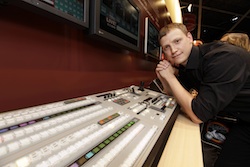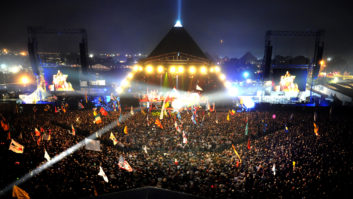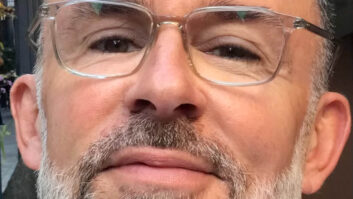
The market for vision mixers (production switchers) is picking up, and remains competitive across all areas of TV broadcast production. Philip Stevens leads TVBEurope’s unique Vision Mixer Round Table in conversation with Blackmagic, FOR-A, Grass, NewTek, Ross, Snell and Sony.
What are the biggest challenges facing the manufacturers of broadcast vision mixers right now? What are the greatest innovations in the sector in the last 10 years? What role does 3D now play in the broadcast production environment? How much delay is acceptable in OB production – and what does the future hold for broadcast vision mixers? Are the current range of vision mixers really self-op friendly – given the pressures for directors to cut their own shows?
The participants (in alphabetical order) in TVBEurope’s first Roundtable discussion are Stuart Ashton (pictured), EMEA director of Blackmagic Design; John Carter, senior product manager at Snell; Andrew Cross, Chief Technology Officer, NewTek; Andrew Hotten, product specialist group leader at Sony; Peter Jones, managing director FOR-A (UK); Scott Murray, VP Product Marketing, Grass Valley; and Nigel Spratling, marketing product manager at Ross Video.
TVBEurope: What has been your greatest challenge over the past 12-24 months?
Carter: Our greatest challenge is to continue getting the word out about the multi-format capabilities Kahuna can bring. One exciting announcement is the launch of the Kahuna 360, the world’s first true 1080p switcher.
Cross: Our challenge has been looking at the industry with an eye toward changing things — instead of accepting the status quo. Our goal is to provide innovative products that help more people deliver dynamic, professional live video content to every screen, from LED displays to laptops to mobile phones.
Hotten: Probably the biggest challenge has been the requirement for 3D production. Our MVS range of switchers has been used for many 3D productions and can be configured to handle either 3D dual link (separate L + R connections) or 3D on 3G (where a single 3G interface can handle both channels together).
Jones: The overall market for live vision mixers is picking up, which is a good market sign. FOR-A is market leader in small mixers, but our challenge is to become the same for large mixers.
Murray: The greatest challenge is not a technology problem but the economic situation. The production community has been pushed to even higher standards – HD, more cameras, more graphics and effects – but at the same time is having to work within ever tighter budgets.
Spratling: Ross Video business was up 47% in the past year, so I guess our main challenge has been to grow our business while continuing to offer the great customer support and service for which we are known.
TVBEurope: Vision mixers have come a long way in the past 10 years or so – what do you think has been the greatest innovation?
Carter: When Kahuna was launched, it revolutionised live production as the world’s first vision mixer to offer multi-format operations within the same mainframe – providing a means of progressing from SD to HD operations. This has brought about a fundamental shift in the market for vision mixers.
Cross: First, the addition of streaming video into the production workflow. Secondly, the collective innovations that have made it possible for a whole new breed of video producers to get into the market. While broadcasters and traditional video producers have embraced new integrated video mixer systems, it is now possible for those who would never have been able to get ‘on TV’ to create and distribute original productions, live, to a global audience.
Jones: Over the last decade vision mixers do more than they did before. For example, DVEs are often included. You can also get very useful infrastructure built-in such as frame synchronisers and up/down converters. They can accept a wider range of signals – such as video from PCs. Another feature is the built-in multi-viewer. If you add all that up and can squeeze it into a small rack-frame box you have very useful on-the-road mixers.
Murray: Bringing more functionality with more creative capabilities. In particular, our customers tell us they need to produce multiple feeds from the same event. It might be a different output for SD and HD, or it might be separate home team and away team cuts from a game, or feeds for in-vision screens, or online services.
Spratling: The exponential growth in Field Programmable Gate Array (FPGA) technology has allowed vision mixers to be designed with many additional functions that required external devices 10 years ago. This technology has allowed Ross to achieve industry firsts like AuxKeys (multiple mini- MEs) and integrated multi-viewers without having to create new hardware.
TVBEurope: What features have proved to be the most popular?
Carter: Without a doubt, FormatFusion — the underlying technology that enables SD material from any source to be integrated into an HD production without the need for upconversion. I’d also include powerful mix/effect architecture, DVE package, internal storage, and a simple means of control.
Cross: With the increased demand for live video and the direction that budgets are headed, an integrated solution like the TriCaster comprising multiple capabilities is very important. For instance, a small crew in a van or OB truck can now cover a game, in situations where it used to take a bigger vehicle.
Jones: Built-in up-/down converters and synchronisers, built-in multiviewers, to size down rack frame sizes, adding central controls for effects and sources.
Spratling: While there are many new features and functions, it’s probably the consolidation of features that provides the most benefit and popularity. Certainly moving multi-viewers internally stands out, but having more MEs, keyers, mini-MEs, internal Media Storage, signal conversion and the ability to automate production control, combine to make a much more desirable product.
TVBEurope: For many productions, only a fraction of the capacity of the mixer is used. Is the massive capability of the equipment a request from users?
Ashton: We always want to give the user what they want and more. If we can offer further functionality for the same price, then we always try to do that. Our customers need to be prepared for any eventuality, especially with the growing trend of ‘pop-up’ television stations and the immediacy of today’s news. Which is why we offer a variety of switchers, to fit in with any workflow, and it’s the users’ choice to pick the best solution.
Jones: User requests have driven the development of multiple MEs. This is not for throwing tons of effects on to the TV screen, but to make TDs’ life easier and make complex live productions manageable. But then if you drive on unexpected terrain, it is always good to have some extra horsepower and security on board.
Murray: We make modular mixers for this very reason. The big trucks used on premium sports know they need as many inputs as they can get. For a smaller truck or studio you might want fewer inputs, and maybe even one or two fewer M/E banks. With a modular mixer like the Kayenne or the new Karerra, you have exactly the same functionality with the keys in exactly the same place on a smaller switcher.
Spratling: The answer is – both. Many sports producers require the ability to make snap production decisions and multi-ME mixers allow the TD to have alternative choices set and ready in this high-pressure environment.
TVBEurope: Many production facilities and broadcasters are getting directors to carry out vision mixing. Are the current range of vision mixers really self-op friendly?
Ashton: Yes, at the forefront of our products is the desire to make them user friendly, which is why Blackmagic Design offers solutions for small, medium and large studios. We also offer a common software interface and both of our hardware control surfaces are easy to use and have intuitive menu systems.
Carter: One feature geared to directors (and unique to Snell) is Galaxy, an event-driven tool that allows directors to automate elements within a show. This helps the director stay focused on the show and not on the mechanics of the mixer.
Cross: TriCaster allows not only directors, but also new members of the television staff to cover whole new events, programmes, stories, breaking news that were never covered before because of budgets and personnel considerations. But is it really self-op friendly? We have customers with productions where volunteers run an entire show.
Hotten: Using the smart and legend-able buttons on the control surface it is very easy for any operator or director to cut a programme. Any complex effects can be pre-loaded in advance on to a specific button and labelled accordingly. In a football match, for example, two clip transitions can be loaded on two separate buttons and labelled ‘Team A Goal’ and ‘Team B Goal’. When a goal is subsequently scored the director can instantly run the animation effect and create the required on-air effect.
TVBEurope: How are you gearing up to handle the demands for 3D production?
Ashton: Blackmagic Design has been developing products for 3D production for a number of years now. We have various internal and external cards for 3D workflows, which includes our DeckLink, Intensity and UltraStudio range. More recently, we announced the acquisition and release of the Teranex VC-100 for 2D to 3D broadcast conversions. Like with any new technology, if our customers ask us for it, we’ll do our best to meet their demands and if possible, exceed them.
Carter: Snell switchers handle 3D production as simply as 2D production — in fact, we had the industry’s first switcher to manage both 2D and 3D signals within a single unit, with built-in capabilities that can help bring left-right disparity and other image quality issues back within acceptability. Built-in 3D features include common stereoscopic control such as convergence correction, camera calibration, and camera orientation.
Hotten: In a very basic way the majority of switchers can handle 3D production. As long as you can link two sources (on two separate busses) you can make a 3D transition. We also offer a dedicated 3D mode. Once the L & R signals are connected to the relevant BNCs and 3D mode is enabled the operator can cut the programme from a single ME strip.
TVBEurope: Moving to some technical questions posed by users, can today’s vision mixers fully handle embedded audio?
Carter: Kahuna does indeed handle embedded audio, enabling the user to easily select the source desired for use on a given output. Also, our ClipTrax feature takes advantage of embedded audio, allowing users to add audio accompaniment to a clip transition such as a breaking news jingle.
Murray: The problem is that some of the things you can do in a production switcher need an enormous amount of processing. That introduces latency through the switcher, which may not be consistent because of the way you build effects. The jump in latency will be invisible, but it will be very distractingly audible. The solution we have at the moment is an option by which you can put the switcher in a fixed delay mode, so there are no audio glitches, at the expense of a latency which may be longer than you ideally want.
TVBEurope: A studio manager states: “The delay, especially these all-in-one-production-in-a-box units, is a real frustration. Three frames is completely un-usable in any live ‘on to big screen’ environment.”
Ashton: Latency is a big issue, especially for live events. There is a level of acceptability though and we find one line latency when all the sources are synchronised is okay for most people.
Jones: True! That’s why FOR-A mixers have a low delay mode to make sure what happens on stage matches with what is happening on the large screens behind! Our mixers can have a delay of about half a line, which makes it a real vision mixer as far as I see it.
Spratling: We agree, delay is a bad thing in live production and many new small mixers have built-in format conversion and synchronisation, which if used will add processing delay.
TVBEurope: Finally, what is your prediction for the future developments?
Carter: Users are looking for more freedom and flexibility to share resources and build the exact systems they need. We have responded through the development of our MakeMe technology, which allows operators to custom-build their own M/E feature sets to match specific production requirements.
Cross: Increased complexity combined with the need for easy-to-use equipment. TriCaster provides HD virtual sets at a quality and complexity never seen before in a video mixer. In our latest models, there is the capability to ISO record up to eight channels of video. The future is in pushing the technological limits while also making it accessible AND powerful.
Hotten: Flexibility and integration are two key areas for ongoing development. Customers in fixed installations are requesting the ability to control any studio from any gallery and move all the associated resources by flicking a switch. They are also requesting greater integration with external devices and the ability to control all parameters of the switcher from an automation system.
Jones: Technical resources such as chromakeys or effects will be floating inside the engine to wherever they are needed. Several control positions or even two or more control rooms and different productions will access the resources of one single central point of production.
Murray: NAB is just coming up. I strongly recommend you visit our booth to see what we see as the future in functionality, realtime control and – perhaps most important – pricing.
Spratling: Adding more functionality for less cost while continuing to bring the rest of the production equipment under the TD’s control is always our goal. Our OverDrive Automated Production Control System is a Vision add-on that enables complete control over video, audio, robotic cameras, video servers and graphics from one person.
www.blackmagic-design.com
www.snellgroup.com
www.newtek.com
www.sony.co.uk
www.for-a.com
www.grassvalley.com
www.rossvideo.com







